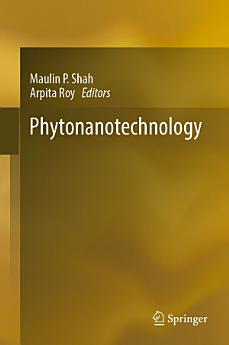Phytonanotechnology
Maulin P. Shah · Arpita Roy
ਸਤੰ 2022 · Springer Nature
ਈ-ਕਿਤਾਬ
336
ਪੰਨੇ
reportਰੇਟਿੰਗਾਂ ਅਤੇ ਸਮੀਖਿਆਵਾਂ ਦੀ ਪੁਸ਼ਟੀ ਨਹੀਂ ਕੀਤੀ ਗਈ ਹੈ ਹੋਰ ਜਾਣੋ
ਇਸ ਈ-ਕਿਤਾਬ ਬਾਰੇ
This book provides essential information on the role of phytonanotechnology in the removal of environmental pollutants and covers recent advances in experimental and theoretical studies on plant-derived nanoparticles. It also discusses their current and potential applications and challenges.The combination of nanotechnology and phytoremediation, which is called phytonanotechnology, have the potential to remove contaminants from the environment or degrade them. The efficiency of contaminant removal can be improved by combining both methods as they are complementary to each other.Phytonanotechnology offers the advantages of increased bioavailability, prolongation of heavy metal absorption time, and multiple metal removal, all contributing to improved efficacy and decreased toxicity in plants and surroundings. Therefore, there is immense scope for nature-derived molecules to be formulated into nanotechnology-based phytoremediation approaches targeting the specific heavy metal removal from effluents and surroundings. This encourages research initiatives to synthesize more phytonanotechnology based uptake plant systems with high efficiency. Efficient formulation targeting strategies and the evaluation of targeting efficiency of phytonanotechnology, conforming to international standards of their toxicology and biocompatibility, could pave the way for heavy metal uptake and removal by plant-based systems./divThis book serves as a valuable resource for postgraduate students, environmental scientists and materials scientists in academia and corporate research.
ਲੇਖਕ ਬਾਰੇ
Dr. Maulin P. Shah is interested in genetic adaptation processes in bacteria. He has more than 120 research publications in highly reputable national and international journals. He directs the research program at Enviro Technology Ltd., Ankleshwar, India. He has guided more than 100 post-graduate students in various disciplines of life science. He is an active editorial board member in more than 150 renowned journals in the field of environmental and biological sciences. He was the founder and editor-in-chief of the International Journal of Environmental Bioremediation and Biodegradation (2012–2014) and the Journal of Applied & Environmental Microbiology (2012–2014) [Science and Education publishing (SciEP), USA]. He is also serving as a reviewer for various journals of national and international repute. Recently, he has been awarded a Young Biotechnologist Medal by the Biotechnological Society of Nepal. He has edited 115 books in the area of wastewater microbiology and industrial wastewater Treatment. He is the Editor In Chief of Biotechnology & Genetic Engineering Reviews- Taylor & Francis.
Arpita Roy is currently working as an assistant professor in the Department of Biotechnology, Sharda University, India, with a specialisation in plant biotechnology, nanobiotechnology, environmental biotechnology and microbiology. She has been teaching graduate- and postgraduate-level biotechnology. She has taught topics related to plant biotechnology, microbiology, bioprocess engineering and solid waste management. She has authored more than 25 scientific articles and 14 book chapters. She has participated and presented at numerous state, national and international conferences, seminars, workshops and symposiums. She has received the Commendable Research Award for excellence in research during the years 2019, 2020 and 2021 from Delhi Technological University, and she has served as an editorial board member and reviewer of international journals.
Arpita Roy is currently working as an assistant professor in the Department of Biotechnology, Sharda University, India, with a specialisation in plant biotechnology, nanobiotechnology, environmental biotechnology and microbiology. She has been teaching graduate- and postgraduate-level biotechnology. She has taught topics related to plant biotechnology, microbiology, bioprocess engineering and solid waste management. She has authored more than 25 scientific articles and 14 book chapters. She has participated and presented at numerous state, national and international conferences, seminars, workshops and symposiums. She has received the Commendable Research Award for excellence in research during the years 2019, 2020 and 2021 from Delhi Technological University, and she has served as an editorial board member and reviewer of international journals.
ਇਸ ਈ-ਕਿਤਾਬ ਨੂੰ ਰੇਟ ਕਰੋ
ਆਪਣੇ ਵਿਚਾਰ ਦੱਸੋ
ਪੜ੍ਹਨ ਸੰਬੰਧੀ ਜਾਣਕਾਰੀ
ਸਮਾਰਟਫ਼ੋਨ ਅਤੇ ਟੈਬਲੈੱਟ
Google Play Books ਐਪ ਨੂੰ Android ਅਤੇ iPad/iPhone ਲਈ ਸਥਾਪਤ ਕਰੋ। ਇਹ ਤੁਹਾਡੇ ਖਾਤੇ ਨਾਲ ਸਵੈਚਲਿਤ ਤੌਰ 'ਤੇ ਸਿੰਕ ਕਰਦੀ ਹੈ ਅਤੇ ਤੁਹਾਨੂੰ ਕਿਤੋਂ ਵੀ ਆਨਲਾਈਨ ਜਾਂ ਆਫ਼ਲਾਈਨ ਪੜ੍ਹਨ ਦਿੰਦੀ ਹੈ।
ਲੈਪਟਾਪ ਅਤੇ ਕੰਪਿਊਟਰ
ਤੁਸੀਂ ਆਪਣੇ ਕੰਪਿਊਟਰ ਦਾ ਵੈੱਬ ਬ੍ਰਾਊਜ਼ਰ ਵਰਤਦੇ ਹੋਏ Google Play 'ਤੇ ਖਰੀਦੀਆਂ ਗਈਆਂ ਆਡੀਓ-ਕਿਤਾਬਾਂ ਸੁਣ ਸਕਦੇ ਹੋ।
eReaders ਅਤੇ ਹੋਰ ਡੀਵਾਈਸਾਂ
e-ink ਡੀਵਾਈਸਾਂ 'ਤੇ ਪੜ੍ਹਨ ਲਈ ਜਿਵੇਂ Kobo eReaders, ਤੁਹਾਨੂੰ ਫ਼ਾਈਲ ਡਾਊਨਲੋਡ ਕਰਨ ਅਤੇ ਇਸਨੂੰ ਆਪਣੇ ਡੀਵਾਈਸ 'ਤੇ ਟ੍ਰਾਂਸਫਰ ਕਰਨ ਦੀ ਲੋੜ ਹੋਵੇਗੀ। ਸਮਰਥਿਤ eReaders 'ਤੇ ਫ਼ਾਈਲਾਂ ਟ੍ਰਾਂਸਫਰ ਕਰਨ ਲਈ ਵੇਰਵੇ ਸਹਿਤ ਮਦਦ ਕੇਂਦਰ ਹਿਦਾਇਤਾਂ ਦੀ ਪਾਲਣਾ ਕਰੋ।








